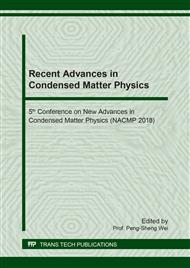[1]
F. Guillou, G. Porcari, H. Yibole, N. van Dijk, E. Brück, Taming the First-Order Transition in Giant Magnetocaloric Materials, Advanced Materials 26 (2014) 2671-2675.
DOI: 10.1002/adma.201304788
Google Scholar
[2]
J. Blázquez, J. Ipus, L. Moreno-Ramírez, J. Álvarez-Gómez, D. Sánchez-Jiménez, S. Lozano-Pérez, V. Franco, A. Conde, Ball milling as a way to produce magnetic and magnetocaloric materials: a review, Journal of Materials Science 52 (2017).
DOI: 10.1007/s10853-017-1089-3
Google Scholar
[3]
B. Shen, J. Sun, F. Hu, H. Zhang, Z. Cheng, Recent progress in exploring magnetocaloric materials, Advanced Materials 21 (2009) 4545-4564.
DOI: 10.1002/adma.200901072
Google Scholar
[4]
P. Nordblad, Magnetocaloric materials: Strained relations, Nature materials 12 (2013) 11-12.
Google Scholar
[5]
A.T. Saito, T. Kobayashi, S. Kaji, J. Li, H. Nakagome, Environmentally friendly magnetic refrigeration technology using ferromagnetic Gd alloys, International Journal of Environmental Science and Development 7 (2016) 316.
DOI: 10.7763/ijesd.2016.v7.791
Google Scholar
[6]
C. Aprea, A. Greco, A. Maiorino, Magnetic refrigeration: a promising new technology for energy saving, International Journal of Ambient Energy 37 (2016) 294-313.
DOI: 10.1080/01430750.2014.962088
Google Scholar
[7]
A. Aryal, A. Quetz, S. Pandey, I. Dubenko, S. Stadler, N. Ali, Magnetocaloric effects and transport properties of rare-earth (R=La, Pr, Sm) doped Ni50-xRxMn35Sn15 Heusler alloys, Journal of Alloys & Compounds 717 (2017) 254-259.
DOI: 10.1016/j.jallcom.2017.05.096
Google Scholar
[8]
Y. Yi, L. Li, K. Su, Y. Qi, D. Huo, Large magnetocaloric effect in a wide temperature range induced by two successive magnetic phase transitions in Ho2Cu2Cd compound, Intermetallics 80 (2017) 22-25.
DOI: 10.1016/j.intermet.2016.10.005
Google Scholar
[9]
Q.L. Ji, Z.G. Zou, F. Long, Y. Wu, Magnetocaloric Properties of Perovskite-Type Manganite La0.65Sr0.2Na0.15MnO3, Key Engineering Materials 697 (2016) 93-96.
Google Scholar
[10]
M. Balli, B. Roberge, P. Fournier, S. Jandl, Review of the Magnetocaloric Effect in RMnO3 and RMn2O5 Multiferroic Crystals, Crystals 7 (2017) 44.
DOI: 10.3390/cryst7020044
Google Scholar
[11]
S. Kumar, I. Coondoo, M. Vasundhara, A.K. Patra, A.L. Kholkin, N. Panwar, Magnetization reversal behavior and magnetocaloric effect in SmCr0.85Mn0.15O3 chromites, Journal of Applied Physics 121 (2017) 043907.
DOI: 10.1063/1.4974737
Google Scholar
[12]
A. Selmi, R. M'Nassri, W. Cheikhrouhou-Koubaa, N.C. Boudjada, A. Cheikhrouhou, Effects of partial Mn-substitution on magnetic and magnetocaloric properties in Pr0.7Ca0.3Mn0.95X0.05O3 (Cr, Ni, Co and Fe) manganites, Journal of Alloys & Compounds 619 (2015).
DOI: 10.1016/j.jallcom.2014.09.078
Google Scholar
[13]
K. Liu, S.C. Ma, L. Zhang, Y.L. Huang, Y.H. Hou, G.Q. Zhang, W.B. Fan, Y.L. Wang, Y. Wang, J. Cao, Tuning the magnetic transition and magnetocaloric effect in Mn1-xCrxCoGe alloy ribbons, Journal of Alloys & Compounds 690 (2017) 663-668.
DOI: 10.1016/j.jallcom.2016.08.126
Google Scholar
[14]
J.Q. Zhao, H.X. Zhu, C.L. Zhang, Y.G. Nie, H.F. Shi, E.J. Ye, Z.D. Han, D.H. Wang, Magnetostructural transition and magnetocaloric effect in a MnCoSi-based material system, Journal of Alloys & Compounds 735 (2018) 959-963.
DOI: 10.1016/j.jallcom.2017.11.204
Google Scholar
[15]
F. Hu, B. Shen, J. Sun, Magnetic entropy change in NiMnGa alloy, Applied Physics Letters 76 (2000) 3460.
Google Scholar
[16]
S. Stadler, M. Khan, J. Mitchell, N. Ali, A.M. Gomes, I. Dubenko, A.Y. Takeuchi, A.P. Guimarães, Magnetocaloric properties of Ni2Mn1-xCuxGa, Applied Physics Letters 88 (2006) 192511.
DOI: 10.1063/1.2202751
Google Scholar
[17]
M. Pasquale, C. Sasso, L. Lewis, L. Giudici, T. Lograsso, D. Schlagel, Magnetostructural transition and magnetocaloric effect in Ni55Mn20Ga25 single crystals, Physical Review B 72 (2005) 094435.
DOI: 10.1103/physrevb.72.094435
Google Scholar
[18]
W. Ito, Y. Imano, R. Kainuma, Y. Sutou, K. Oikawa, K. Ishida, Martensitic and Magnetic Transformation Behaviors in Heusler-Type NiMnIn and NiCoMnIn Metamagnetic Shape Memory Alloys, Metallurgical & Materials Transactions A 38 (2007) 759-766.
DOI: 10.1007/s11661-007-9094-9
Google Scholar
[19]
T. Krenke, M. Acet, E.F. Wassermann, X. Moya, L. Mañosa, A. Planes, Martensitic transitions and the nature of ferromagnetism in the austenitic and martensitic states of Ni-Mn-Sn alloys, Physical Review B 72 (2005) 014412.
DOI: 10.1103/physrevb.72.014412
Google Scholar
[20]
T. Krenke, M. Acet, E.F. Wassermann, X. Moya, L. Mañosa, A. Planes, Ferromagnetism in the austenitic and martensitic states of Ni-Mn-In alloys, Physical Review B 73 (2006) 174413.
DOI: 10.1103/physrevb.73.174413
Google Scholar
[21]
F. Chen, Y. Tong, L. Li, J.S. Llamazares, C. Sánchez-Valdés, P. Müllner, The effect of step-like martensitic transformation on the magnetic entropy change of Ni40.6Co8.5Mn40.9Sn10 unidirectional crystal grown with the Bridgman- Stockbarger technique, Journal of Alloys and Compounds 691 (2017).
DOI: 10.1016/j.jallcom.2016.08.240
Google Scholar
[22]
F. X. Hu, B. G. Shen, J. R. Sun, Magnetic entropy change involving martensitic transition in NiMn-based Heusler alloys, Chinese Physics B 22 (2013) 037505.
DOI: 10.1088/1674-1056/22/3/037505
Google Scholar
[23]
A. Ghosh, K. Mandal, Large magnetic entropy change and magnetoresistance associated with a martensitic transition of Mn-rich Mn50.5-xNi41Sn8.5+x alloys, Journal of Physics D: Applied Physics 46 (2013) 435001.
DOI: 10.1088/0022-3727/46/43/435001
Google Scholar
[24]
E. Brück, Developments in magnetocaloric refrigeration, Journal of Physics D: Applied Physics 38 (2005) R381.
Google Scholar
[25]
Y. Zhang, J. Liu, Q. Zheng, J. Zhang, W. Xia, J. Du, A. Yan, Large magnetic entropy change and enhanced mechanical properties of Ni-Mn-Sn-C alloys, Scripta Materialia 75 (2014) 26-29.
DOI: 10.1016/j.scriptamat.2013.11.009
Google Scholar
[26]
I. Dincer, E. Yüzüak, Y. Elerman, Influence of irreversibility on inverse magnetocaloric and magnetoresistance properties of the (Ni,Cu)50Mn36Sn14 alloys, Journal of Alloys and Compounds 506 (2010) 508-512.
DOI: 10.1016/j.jallcom.2010.07.066
Google Scholar
[27]
I. Dincer, E. Yüzüak, Y. Elerman, The effect of the substitution of Cu for Ni on magnetoresistance and magnetocaloric properties of Ni50Mn34In16, Journal of Alloys and Compounds 509 (2011) 794-799.
DOI: 10.1016/j.jallcom.2010.09.092
Google Scholar


